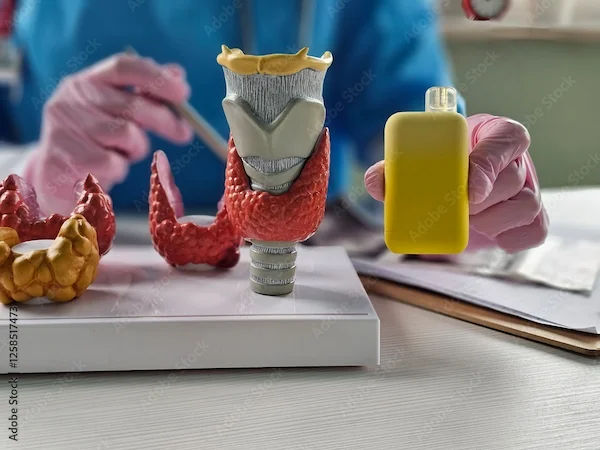5-Minute Exercises for Managing Hyperthyroidism
Learn 5-minute hyperthyroid exercise routines to support thyroid care, ease anxiety, and protect the heart and muscles. Safe tips, FAQs, and trusted sources.

Written by Dr. Vasanthasree Nair
Reviewed by Dr. Rohinipriyanka Pondugula MBBS
Last updated on 25th Nov, 2025

Introduction
Hyperthyroidism can make your heart race, your hands tremble, and your energy feel unpredictable. While medical treatment is essential, short, gentle movement breaks can support thyroid care by easing stress, protecting muscles and bones, and improving sleep. This guide shows you safe hyperthyroid exercise ideas you can do in just five minutes, at home, without equipment, to help you feel steadier day to day. Always check with your healthcare clinician before starting a new routine, especially if your thyroid levels are not yet controlled.
Why Movement Matters in Thyroid Care?
Hyperthyroidism increases your metabolism and puts extra demand on your heart, muscles, and bones. Appropriate movement can help:
- Lower stress and anxiety through breathing and gentle activity
- Maintain muscle strength that can decline with untreated hyperthyroidism
- Support bone health with light-weight-bearing moves
- Improve sleep and mood
- Enhance balance and posture
Important: Exercise does not treat hyperthyroidism. Standard medical care (such as antithyroid medications, radioactive iodine, or surgery) is the foundation of management. Physical activity is a supportive habit you can build around your care plan.
Safety First: How to Make Hyperthyroid Exercise Gentle and Safe?
When hyperthyroidism is not yet controlled, your heart may beat fast and irregularly. That’s why many experts advise avoiding strenuous workouts until your thyroid levels are managed. Keep these safety tips in mind:
- Get medical clearance. If you have chest pain, fainting, severe shortness of breath, very fast or irregular heartbeat, or untreated hyperthyroidism, see your clinician before exercising.
- Start low and slow. Choose low-impact, short sessions (like the five-minute options below).
- Increase only when you feel steady and your clinician agrees.
- Use the talk test. Move at an intensity where you can talk in complete sentences. If you cannot, slow down. This is a practical way to gauge moderate effort.
- Watch your heart rate with caution. Beta-blockers (often prescribed for symptom relief) can lower or blunt your heart-rate response, so rely on the talk test and how you feel.
- Stay cool and hydrated. Exercise in a cool, well-ventilated space, and drink water. Avoid overheating, especially if you’re heat sensitive.
- Mind your eyes. If you have Graves’ eye disease (bulging, pressure, pain, or double vision), avoid positions that increase pressure in the head and eyes (like deep inversions) unless your clinician says they’re safe for you.
- Stop if you feel unwell. Pause and seek care if you have chest pain, dizziness, severe shortness of breath, or a pounding or irregular heartbeat.
Consult a Top General Physician
Your 5-Minute Mini-Workouts
Choose one mini-workout at a time. You can do different ones throughout the day, morning, midday, or evening, to total 10–20 minutes or more, as tolerated. Each routine is designed to be low-impact and supportive of thyroid care.
1) Calm and Reset: Breathing + Mobility (5 minutes)
Goal: Lower stress, calm your heart rate, and ease neck/shoulder tension.
- 1 minute: 4-6 breathing. Inhale through your nose for 4 seconds, exhale for 6 seconds. Keep breathing gently.
- 1 minute: Neck mobility. Slowly look right/left; nod up/down; tilt your ear to your shoulder on each side. Move within comfort, no forcing.
- 1 minute: Shoulder rolls. Roll your shoulders backward 10 times, then forward 10 times.
- 1 minute: Cat-cow standing or on hands and knees. Gently round and lengthen your spine with your breath.
- 1 minute: Seated forward reach. Sit tall, hinge slightly forward, reach arms ahead at chest height, then draw shoulders back and down. Breathe steadily.
Make it easier: Do all moves seated.
Make it slightly harder: Add light resistance band pull-aparts for 30 seconds.
2) Low-Impact Cardio to Steady Energy (5 minutes)
Goal: Light aerobic activity to support circulation and mood without overstraining.
- 1 minute: March in place, swinging arms gently.
- 1 minute: Step taps side-to-side, keeping steps small and controlled.
- 1 minute: Heel digs forward, alternate legs; add a small arm pull-back.
- 1 minute: Mini step-ups on a low, stable step (or continue marching if no step is available).
- 1 minute: Slow walk around the room, letting breathing return toward normal.
Talk test: You should be able to speak in full sentences. If not, slow down.
Make it easier: Hold a stable chair for balance and reduce the range of motion.
Make it slightly harder: Add a gentle knee lift or small arm reaches overhead if comfortable.
3) Strength Micro-Circuit for Muscles and Bones (5 minutes)
Goal: Maintain muscle and bone strength with simple, controlled moves.
Perform the following with good posture. Repeat the circuit twice if time allows.
- 45 seconds: Sit-to-stand. From a chair, stand up and sit down slowly. Use your hands on the chair if needed.
- 45 seconds: Wall push-ups. Hands at chest height on a wall, step back slightly, lower and press away.
- 45 seconds: Calf raises. Hold a counter or chair; rise onto toes and lower slowly.
- 45 seconds: Standing hip abductions. Stand tall, hold a chair, lift one leg out to the side without leaning; switch sides halfway.
- 1 minute: Easy cool-down stroll plus shoulder blade squeezes (gently pull shoulders back and down).
Make it easier: Reduce range of motion or reps, and rest as needed.
Make it slightly harder: Slow the lowering phase to 3 seconds, or add a light resistance band.
4) Flexibility and Posture Refresh (5 minutes)
Goal: Counter neck/shoulder tightness and promote comfort while sitting or working.
- 1 minute: Chest opener. Clasp hands behind you (or hold a towel), gently lift hands, and open your chest while keeping your shoulders down.
- 1 minute: Upper back stretch. Cross arms in front, hands on shoulders, gently round upper back, and breathe.
- 1 minute: Side reaches. Reach one arm overhead, lean gently to the opposite side; switch.
- 1 minute: Wrist and forearm stretches. Flex and extend wrists gently in small circles.
- 1 minute: Thoracic rotation. Sit or stand tall, rotate your torso right/left with relaxed breathing.
If you have eye symptoms, keep head positions neutral and avoid long holds upside down.
5) Balance and Foot Activation (5 minutes)
Goal: Improve stability, which can feel off when energy and muscles are taxed.
- 1 minute: Weight shifts. Feet hip-width apart, shift weight front/back and side/side without lifting feet.
- 1 minute: Tandem stance. One foot directly in front of the other, hold a counter; switch after 30 seconds.
- 1 minute: Single-leg stand. Lift one foot slightly; switch after 30 seconds. Tap a toe down anytime for safety.
- 1 minute: Heel-to-toe slow walk along a line, using a wall for light support.
- 1 minute: Ankle ABCs. Lift one foot and “draw” the alphabet with your toes; switch at the halfway.
Safety tip: Stand near a counter or sturdy chair. Keep movements small and controlled.
How to Fit 5-Minute Sessions Into Your Day?
- Morning: Do the Calm and Reset routine to start steady.
- Midday: Choose Low-Impact Cardio or Strength to lift energy.
- Evening: Do Flexibility and Posture to unwind and prepare for sleep.
- Mix and match: Aim for 2–4 short sessions on most days, as tolerated and cleared by your clinician.
Progressing Safely Over Time
- Track how you feel. A simple 0–10 effort scale (aim for 3–4: light to moderate) can help you avoid overdoing it.
- Add minutes gradually. Increase by 1–2 minutes per session or add one extra mini-workout on alternate days if you feel good and your care team agrees.
- Keep it cool. If you’re heat-sensitive, choose cooler times of day, use a fan, and drink water.
- Review medications. Beta-blockers and other medicines can change how exercise feels. Ask your clinician how to monitor intensity.
Special Notes for Graves’ Disease and Eye Symptoms
- Avoid positions that put your head below your heart (deep inversions) or hold breath during effort, which can raise pressure in the head and eyes.
- Choose neutral-head positions, gentle breathing, and short holds.
- If you have double vision or discomfort, keep balance work supported and slow.
Lifestyle Habits That Support Thyroid Care
- Sleep routine: Aim for a regular bedtime and calming wind-down.
- Nutrition: Follow your clinician’s advice. If your appetite is high, choose balanced meals with fiber, protein, and healthy fats to steady energy. Do not start supplements without medical guidance.
- Stress management: Short breathing breaks, brief walks, or a few minutes of stretching can lower stress hormones and help you feel calmer.
- Follow-up: Keep your lab checks and treatment plan. Exercise is supportive; medical therapy is essential for managing hyperthyroidism.
Consult a Top General Physician
Consult a Top General Physician

Dr. Ramya Hari
General Practitioner
18 Years • Medical Head & Family Physician, DG Shipping Approved Doctor, Panel Physician - UK Visa Medicals
Chennai
Apollo Medical Centre Kotturpuram, Chennai

Dr. Afreen Banu Khan
General Physician/ Internal Medicine Specialist
12 Years • MBBS, DDM (Diab). FCC (Cardio)
Chennai
Apollo Speciality Hospitals OMR, Chennai

Dr. Promise Jain
General Physician/ Internal Medicine Specialist
20 Years • MBBS, DNB Medicine, TDD, MNAMS, PGCDM, CCEBDM, CCMTD,PGDE Senior Consultant- Internal Medicine Head- Department of critical care Apollo Sage Hospital, Bhopal, MP Intensivist, Diabetes, Thyroid , Physician
Bhopal
Apollo Sage Hospitals, Bhopal

Dr Vinay Kumar A V
Nephrologist
8 Years • MBBS, MD - General Medicine, DM - Nephrology
Bilaspur
Apollo Hospitals Seepat Road, Bilaspur

Dr. Subashini Venkatesh
General Physician/ Internal Medicine Specialist
25 Years • MBBS., DCH, MRCGP, Dip (Dermatology), CCT
Chennai
Apollo Hospitals Heart Centre Thousand Lights, Chennai
(25+ Patients)
Consult a Top General Physician

Dr. Ramya Hari
General Practitioner
18 Years • Medical Head & Family Physician, DG Shipping Approved Doctor, Panel Physician - UK Visa Medicals
Chennai
Apollo Medical Centre Kotturpuram, Chennai

Dr. Afreen Banu Khan
General Physician/ Internal Medicine Specialist
12 Years • MBBS, DDM (Diab). FCC (Cardio)
Chennai
Apollo Speciality Hospitals OMR, Chennai

Dr. Promise Jain
General Physician/ Internal Medicine Specialist
20 Years • MBBS, DNB Medicine, TDD, MNAMS, PGCDM, CCEBDM, CCMTD,PGDE Senior Consultant- Internal Medicine Head- Department of critical care Apollo Sage Hospital, Bhopal, MP Intensivist, Diabetes, Thyroid , Physician
Bhopal
Apollo Sage Hospitals, Bhopal

Dr Vinay Kumar A V
Nephrologist
8 Years • MBBS, MD - General Medicine, DM - Nephrology
Bilaspur
Apollo Hospitals Seepat Road, Bilaspur

Dr. Subashini Venkatesh
General Physician/ Internal Medicine Specialist
25 Years • MBBS., DCH, MRCGP, Dip (Dermatology), CCT
Chennai
Apollo Hospitals Heart Centre Thousand Lights, Chennai
(25+ Patients)
More articles from Hyperthyroidism overactive thyroid
Frequently Asked Questions
Can exercise worsen hyperthyroidism?
Strenuous workouts can overtax your heart when hyperthyroidism is uncontrolled. Stick with light to moderate hyperthyroid exercise (use the talk test) and get medical clearance first. As treatment brings your thyroid levels toward normal, you can usually do more, with your clinician’s guidance.
How often should I do these 5-minute routines?
Start with 1–2 sessions per day, most days of the week, if your clinician approves. Many people feel better spacing movement through the day, such as morning breathing and an afternoon walk, rather than doing longer sessions.
What should I avoid if I have Graves’ eye disease?
Avoid deep inversions and breath-holding, which can increase pressure in your head and eyes. Keep your neck in neutral positions, use gentle breathing, and choose supported balance work. Ask your eye specialist for personalized guidance.
How do I know the right intensity if I’m on a beta-blocker?
Beta-blockers can lower your resting heart rate and blunt your exercise heart-rate response. Use the talk test and perceived effort instead: you should be able to talk in full sentences and feel light to moderate effort.
Is strength training safe with hyperthyroidism?
Yes, light, controlled strength work supports muscles and bones, which can be affected by hyperthyroidism. Start with bodyweight moves (like wall push-ups and sit-to-stands), keep breathing steady, and progress slowly after medical clearance.



